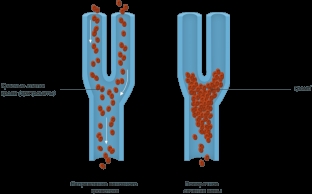Deep vein thrombosis is a condition that occupies a separate place among medical diagnoses due to the high likelihood of complications, which in many cases lead to death. This is a pulmonary embolism. PE appears on the background of deep vein thrombosis of the lower extremities and small pelvis. The condition develops abruptly with acute symptoms. In rare cases, the patient can be saved, so it is extremely important to identify deep vein thrombosis at an early stage and eliminate it. How deep vein thrombosis manifests itself, and what are the important aspects of its treatment, read in our article.
Causes and mechanism of development of deep vein thrombosis
Deep vein thrombosis occurs when several factors are present at the same time – slow blood flow, pathologies in the blood coagulation system and damage to the inner wall of the vein after the action of a chemical, mechanical, infectious or allergic agent.
When the wall of the venous vessel is damaged, the risk of blood clots at the site of damage increases. With an increase in blood viscosity, blood flow slows down, which also contributes to the formation of blood clots. A thrombus, formed on the wall, provokes the development of inflammation and further damage to the wall. Stagnation of blood in the venous system contributes to the formation of blood clots in the deep veins.
The risk of developing deep vein thrombosis increases many times when taking oral contraceptives, after infectious diseases and injuries, oncological pathologies, DIC. Prolonged sitting significantly increases the risk of thrombosis due to the obstruction of the normal outflow of blood from the veins of the lower extremities. After operations on the legs, the muscles are significantly weakened and lose their ability to normal contraction, after which blood stagnation develops in the deep veins of the lower extremities.
Deep vein thrombosis can also be observed in the upper limb after some procedures - vein catheterization, implantation of a cardiofibrillator, in addition, with an intense load on the hands of athletes, as well as with malignant tumors in the vein.

What are the clinical manifestations of deep vein thrombosis?
In the initial stages of deep vein thrombosis, blood flow disorders and thrombus formation, the body compensates for this violation by the development of communicating veins. Thus, blood flows from the deep veins through the saphenous veins. The course of the disease at this stage is often asymptomatic. Sometimes there are some symptoms that you should pay due attention to:
- Swelling of the superficial veins of the lower extremities.
- Presence of swelling of limb tissues.
- Local temperature increase.
- Painful palpation along a vein with a thrombus.
- Pain of bursting nature in the affected limb.
The presence of a long-standing process of deep vein thrombosis is evidenced by the formation of venous collaterals in the hip joints, lower leg, thigh and lower abdomen.
Diagnosis and treatment of deep vein thrombosis
Diagnosis of deep vein thrombosis is established by a surgeon or phlebologist after testing and assessing the state of blood flow. It manifests itself with the help of a marching test and bandaging of the diseased limb according to a special technique. In order to assess blood flow in deep veins, phlebography, ultrasound of the veins of the lower extremities, duplex scanning and rheovasography are used.
If deep vein thrombosis is present, the patient should be hospitalized immediately. This decision is justified by the high probability of complications - pulmonary embolism, pulmonary infarction, acute respiratory and heart failure. Also, against the background of a long course of deep vein thrombosis, as a rule, chronic venous insufficiency and trophic ulcers develop.
The treatment of deep vein thrombosis should be carried out comprehensively, that is, in addition to surgery, it is important to simultaneously conduct conservative treatment. This therapy regimen, combined with physiotherapy, can completely cure the patient, improve the condition of the veins and prevent dangerous complications.
Effective treatment of deep vein thrombosis in Dr. Lirnik's clinic
Hundreds of people at Dr. Lirnik's Clinic of Vascular Pathology use this comprehensive and effective approach in the treatment of deep vein thrombosis every day. The clinic is equipped with all the necessary facilities for physiotherapy for sick limbs before and after surgery.
The clinic employs experienced specialists who have been able to help many in the fight against deep vein thrombosis. By making an appointment, the patient is guaranteed to receive a specialist consultation, which consists in making a diagnosis and making a conclusion about the need and scope of surgical intervention, about prognosis.
Do not delay visiting Dr. Lirnik's Vascular Clinic if you suspect deep vein thrombosis.







Add a comment